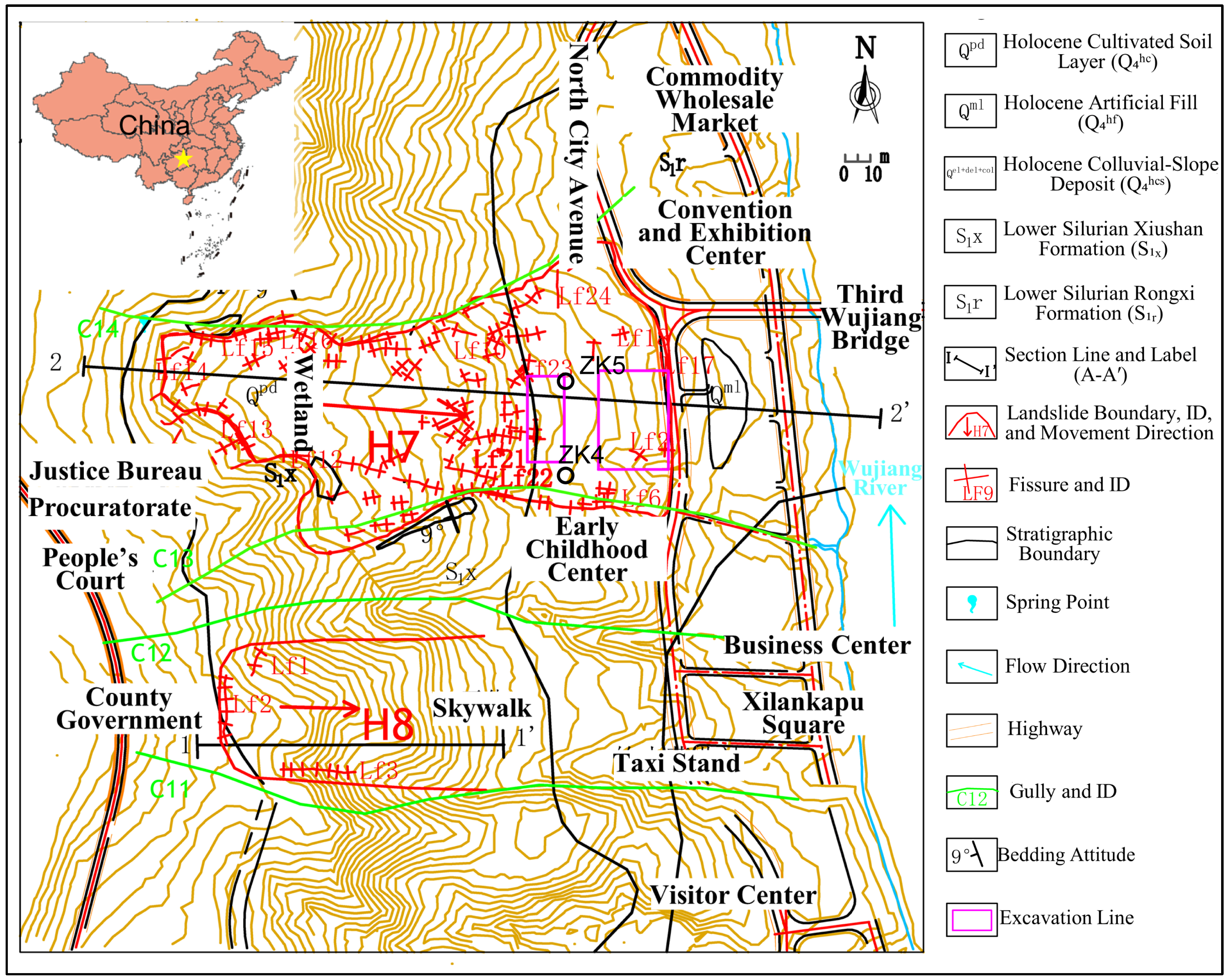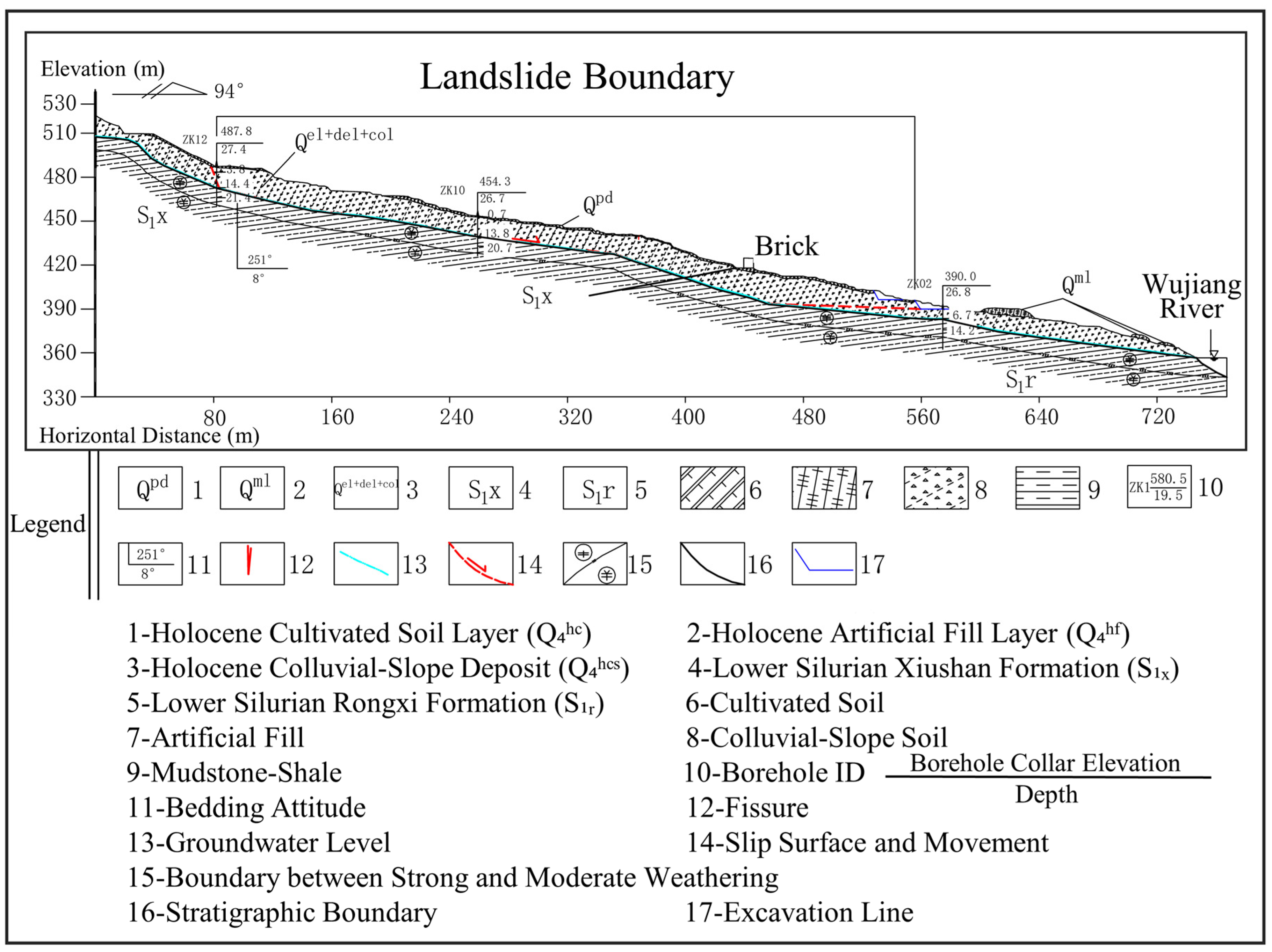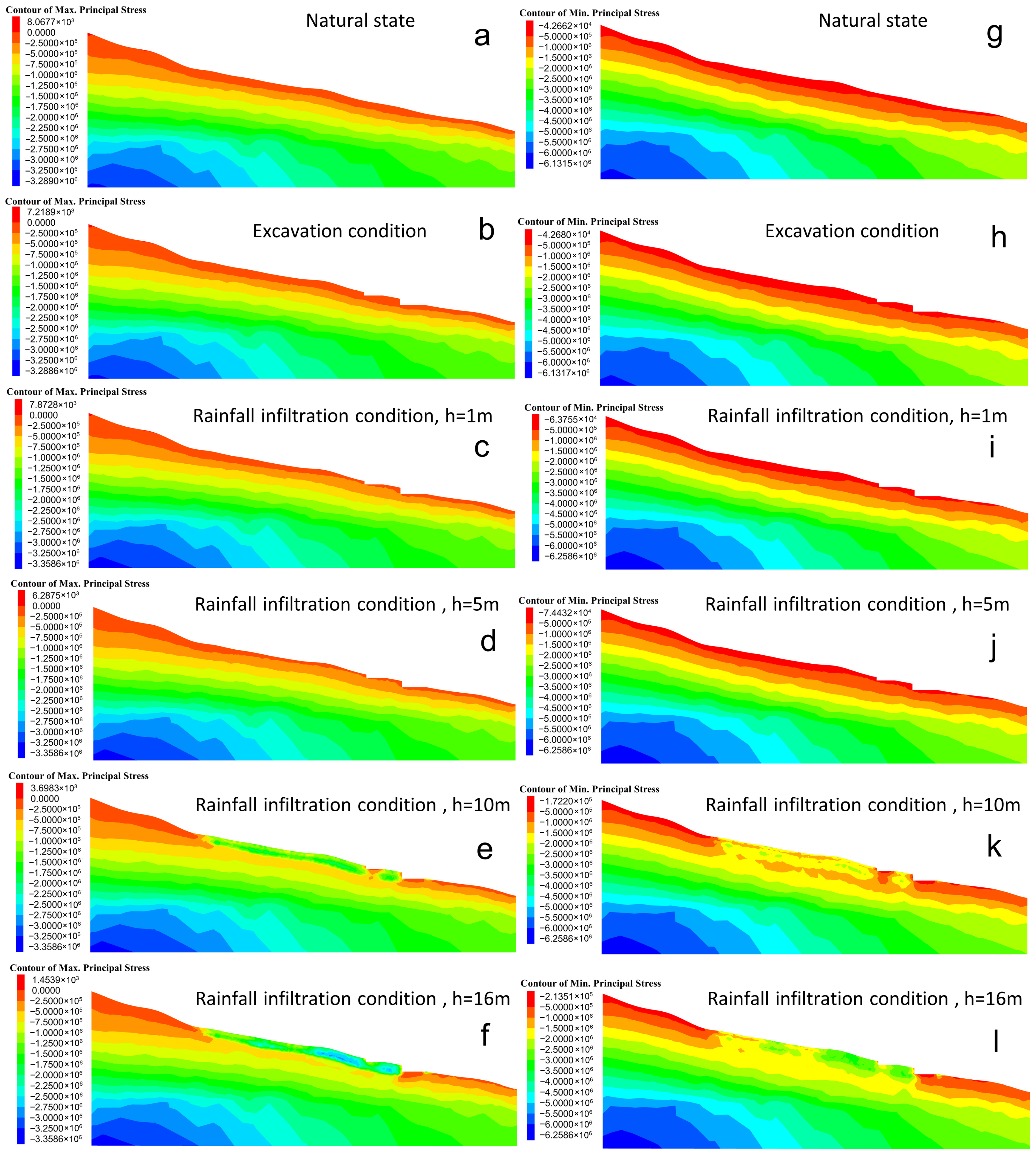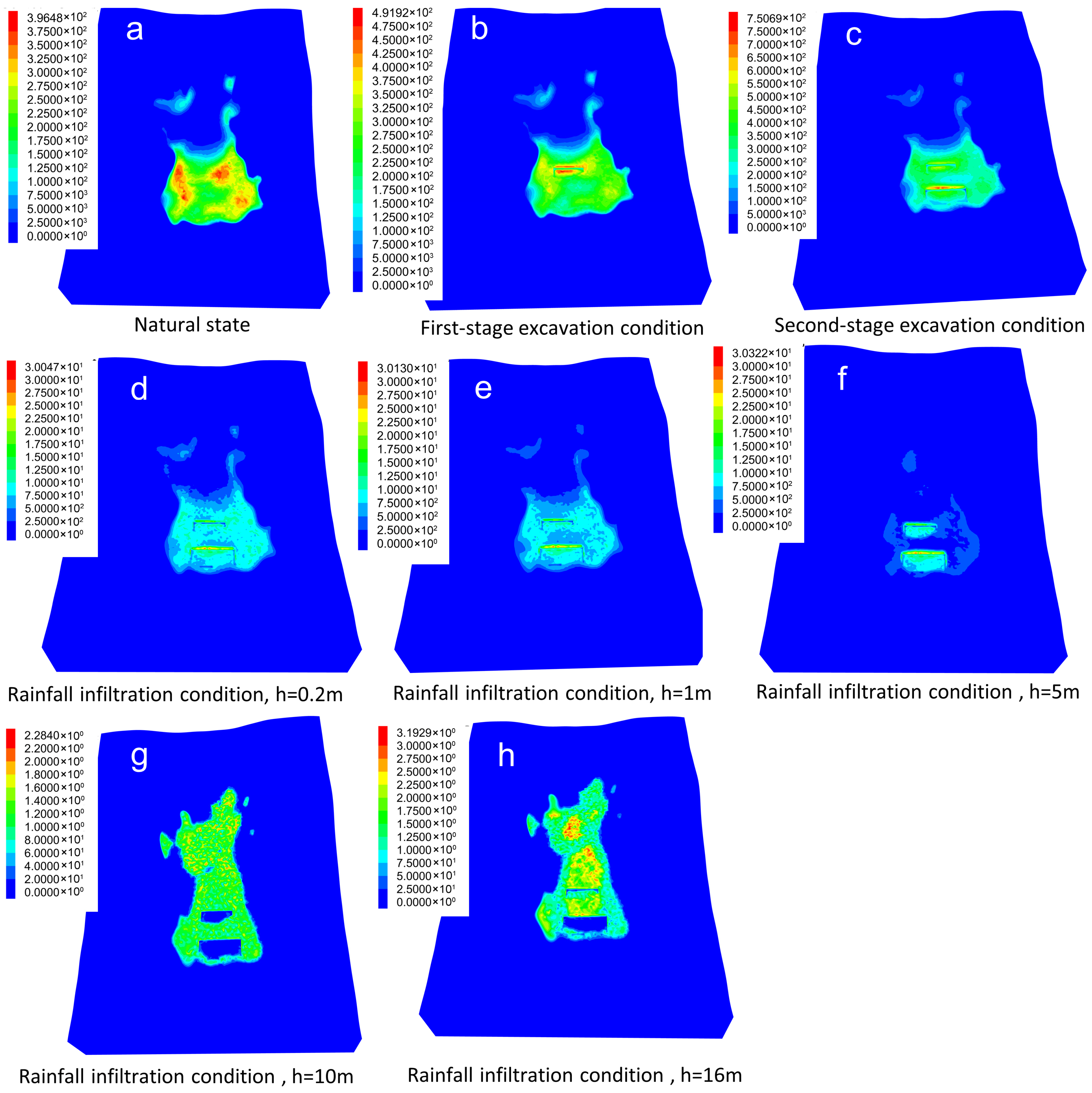Reactivation Mechanism of Ancient Accumulation Landslides Synergistically Triggered by Excavation Disturbance and Critical Rainfall Infiltration
Abstract
1. Introduction
2. Landslide Overview
3. Qualitative Analysis of Landslide Causative Factors
- (I)
- Stage I: Rear Scarp Surface Creep (March/April 2011)
- (II)
- Stage II: Front Excavation-Midsection Creep (End of 2011–Early 2013)
- (III)
- Stage III: Progressive Shear Surface Connection-Comprehensive Reactivation Failure (2013 onwards)
4. Three-Dimensional Numerical Analysis of Landslide Causative Mechanism
4.1. Model Overview
4.2. Boundary and Initial Conditions
- (1)
- Initial Conditions
- (2)
- Hydraulic Head Boundary Conditions
- (3)
- Displacement Boundary Conditions
4.3. Material Parameter Selection
- (1)
- Rock-Soil Mass Physico-Mechanical Parameterization
- (2)
- Rainfall Scenario Parameterization
4.4. Computational Procedure
- (1)
- Initial Stress State Validation: An initial simulation of the slope under natural conditions established a benchmark, verifying model stability and parameter appropriateness. Upon successful completion, all accumulated displacements were reset to zero before applying subsequent disturbance perturbations. This step was crucial for assessing subsequent stability changes relative to the verified initial state.
- (2)
- Anthropogenic Excavation Simulation: Slope modifications via mid-lower and front-flank excavations were simulated. Using the original topography as a baseline, excavation sequences followed actual engineering sequences (top-down) based on cut-fill design lines. Stability changes induced purely by excavation were analyzed.
- (3)
- Rainfall Infiltration Impact Simulation: The saturated infiltration scenarios examined the destabilizing effects of (i) elevated groundwater tables softening the basal slip zone material, (ii) increased driving forces due to rising saturated unit weight, and (iii) destabilizing seepage-induced hydrodynamic pressures. Fluid–solid coupling was explicitly activated for these analyses. Longdongpo landslide is situated in the mid-slope section, with a longitudinal extent of approximately 650 m and a width ranging between 100 and 300 m. The landslide toe is located about 160 m from the contemporary riverbed. The toe elevation (385–390 m) significantly exceeds the normal pool level (365 m) of the dam reservoir. Consequently, the influence of reservoir water levels is disregarded in this study given the substantial elevation difference.
4.5. Analysis of Simulation Results
4.5.1. Evolution of Stress Field Characteristics
4.5.2. Evolution of Displacement Field Characteristics
4.5.3. Evolution of Plastic Zone Characteristics
4.5.4. Pore Water Pressure Response Characteristics
5. Discussion
6. Conclusions
- (1)
- Longdongpo constitutes a reactivated large-scale, mid-thick colluvial paleolandslide exhibiting an elongated tongue morphology (primary sliding direction: 92°, longitudinal length 650 m, average thickness 12 m, volume ~160 × 104 m3). The sliding mass consists of colluvial silty clay with rock fragments (gravel content 20–35%), with the basal slip zone demarcating the Quaternary–Silurian intensely weathered mudstone interface. Its destabilization resulted from compounding factors: unfavorable geotechnical configurations (fundamental predisposition), anthropogenic excavation (contributing factor), and sustained rainfall (triggering mechanism), with evolutionary stages comprising rear-scarp superficial creep—Stage (I); ore excavation with associated mid-slope creep progression—Stage (II); lip surface coalescence–global reactivation failure—Stage (III).
- (2)
- FLAC3D fluid–solid coupled simulations quantitatively establish reactivation as a chained process: “long-term groundwater weakening → excavation-induced hydrologic disruption → critical-depth rainfall triggering”. (a) Long-Term Weakening: Groundwater persistently softens the slip zone, degrading its shear resistance. (b) Excavation Disruption: Critically alters natural drainage pathways, impeding slope drainage (core action). (c) Critical Rainfall Threshold: The 5 m critical infiltration depth was determined based on the gravelly soil’s permeability (k = 3.5 × 10−5 m/s as measured) and the slip zone’s hydraulic-structural configuration. At h > 5 m, rapid deep infiltration (controlled by gravelly soil permeability and fractures) accumulates in excavation-disrupted drainage zones. This induces pore pressure surge (>2.7 MPa), water-weight loading, sharp reduction in slip zone effective strength, and increased driving force. These jointly provoke plastic zone connection (pervasive “shear-n shear-p” yielding) and catastrophic displacement acceleration (>2.2 m), culminating in global failure.
Author Contributions
Funding
Data Availability Statement
Conflicts of Interest
References
- Jiang, S. Study of landslide geological hazard prediction method based on probability migration. Nat. Hazards 2021, 108, 1753–1762. [Google Scholar] [CrossRef]
- Sassa, S. Landslides and Tsunamis: Multi-Geohazards. Landslides 2023, 20, 1335–1341. [Google Scholar] [CrossRef]
- Tan, Q.; Bai, M.; Zhou, P.; Hu, J.; Qin, X. RETRACTED: Geological hazard risk assessment of line landslide based on remotely sensed data and GIS. Measurement 2021, 169, 108370. [Google Scholar] [CrossRef]
- Su, Y.; Rong, G.; Ma, Y.; Chi, J.; Liu, X.; Zhang, J.; Li, T. Hazard Assessment of Earthquake Disaster Chains Based on Deep Learning—A Case Study of Mao County, Sichuan Province. Front. Earth Sci. 2022, 9, 683903. [Google Scholar] [CrossRef]
- Yin, D.; Zhang, B.; Yan, J.; Luo, Y.; Zhou, T.; Qin, J. CoWNet: A correlation weighted network for geological hazard detection. Knowl.-Based Syst. 2023, 275, 110684. [Google Scholar] [CrossRef]
- Zhong, J.; Li, Q.; Zhang, J.; Luo, P.; Zhu, W. Risk Assessment of Geological Landslide Hazards Using D-InSAR and Remote Sensing. Remote. Sens. 2024, 16, 345. [Google Scholar] [CrossRef]
- Jia, Y.; Jia, S.; Pang, R. Measurement and impact analysis of social vulnerability to geological disasters in Guizhou Province, China. Sci. Rep. 2024, 14, 25098. [Google Scholar] [CrossRef]
- Zhu, Q.; Yuan, H.; Wang, L.; Zeng, C.; Bashir, M.; Vasudevan, N.; Sethupathi, S. A Study on Risk Assessment of Geological Disasters in Pingba District of Guizhou Province Based on GIS. In Proceedings of the E3S Web of Conferences, 2023 9th International Conference on Energy Materials and Environment Engineering (ICEMEE 2023), Guilin, China, 25–27 August 2023. [Google Scholar] [CrossRef]
- Zou, F.; Che, E.; Long, M. Quantitative assessment of geological hazard risk with different hazard indexes in mountainous areas. J. Clean. Prod. 2023, 413, 137467. [Google Scholar] [CrossRef]
- Chen, J.; Xu, C. Geological Hazards and Risk Management. Sustainability 2024, 16, 3286. [Google Scholar] [CrossRef]
- Wu, Z.; Ye, R.; Yang, S.; Wen, T.; Huang, J.; Chen, Y. Study on Early Identification of Rainfall-Induced Accumulation Landslide Hazards in the Three Gorges Reservoir Area. Remote. Sens. 2024, 16, 1669. [Google Scholar] [CrossRef]
- Yang, X.; Diao, X.; Zhou, T.; Hu, F.; Wang, S. Study on the Stability of Accumulated Layer Landslide under the Coupling Action of Earthquake and Rainfall. KSCE J. Civ. Eng. 2022, 27, 98–108. [Google Scholar] [CrossRef]
- Zhou, C.; Ai, D.; Huang, W.; Xu, H.; Ma, L.; Chen, L.; Wang, L. Emergency Survey and Stability Analysis of a Rainfall-Induced Soil-Rock Mixture Landslide at Chongqing City, China. Front. Earth Sci. 2021, 9, 774200. [Google Scholar] [CrossRef]
- Li, C.; Criss, R.E.; Fu, Z.; Long, J.; Tan, Q. Evolution characteristics and displacement forecasting model of landslides with stair-step sliding surface along the Xiangxi River, three Gorges Reservoir region, China. Eng. Geol. 2021, 283, 105961. [Google Scholar] [CrossRef]
- Zhang, Z.; Wang, T. Failure modes of weak interlayers with different dip angles in red mudstone strata, Northwest China. Bull. Eng. Geol. Environ. 2023, 82, 156. [Google Scholar] [CrossRef]
- Zhou, J.; Zhao, F.; Zhu, Y.; Dong, W.; He, Z.; Wang, P. Dynamic Behavior and Constitutive Relationship of Mudstone Slip Zone of Landslide with Weak Interlayer. Shock. Vib. 2021, 2021, 3330127. [Google Scholar] [CrossRef]
- Li, X.; Zhang, J.; Tian, Y.; Zhao, Y. Assessing hazards of ancient landslide clusters in the Lancang river basin using multi-temporal remote sensing: A case study of Chaya county. Prog. Phys. Geogr. Earth Environ. 2025, 49, 44–62. [Google Scholar] [CrossRef]
- Wu, R.; Zhang, Y.; Guo, C.; Yang, Z.; Ren, S.; Tong, B. Reactivation characteristics and dynamic hazard prediction of an ancient landslide in the east margin of Tibetan Plateau. Environ. Earth Sci. 2018, 77, 573. [Google Scholar] [CrossRef]
- Yang, Z.; Wu, T.; E, C.; Xie, X.; Tan, L.; Jiang, X. A quantitative enhanced assessment for ancient landslide reactivation risk considering cross-time scale joint response mechanism. Front. Earth Sci. 2023, 10, 974442. [Google Scholar] [CrossRef]
- Dai, L.; Jia, C.; Chen, L.; Zhang, Q.; Chen, W. Development Characteristics and Reactivation Mechanism of a Large-Scale Ancient Landslide in Reservoir Area. Appl. Sci. 2024, 14, 3107. [Google Scholar] [CrossRef]
- Guo, C.; Wu, R.; Zhang, Y.; Yan, Y.; Yang, Z.; Zhang, Y.; Wu, Z.; Yuan, H.; Liu, J. Investigation on the development characteristics and reactivation mechanism of the Zhama ancient landslide in Batang County, Eastern Tibetan Plateau, China. Environ. Earth Sci. 2023, 83, 39. [Google Scholar] [CrossRef]
- Wang, R.; Zhang, K.; Ning, Y.; Xu, W.; Wang, W.; Qin, J.; Chen, X. Reactivation of Ancient Landslide Deposits: Geological Characteristics and Deformation Mechanism. Adv. Civ. Eng. 2021, 2021, 6614180. [Google Scholar] [CrossRef]
- Guo, C.; Zhang, Y.; Yuan, H.; Liu, D.; Yan, Y.; Hua, S.; Ren, S. Study of an ancient landslide reactivation mechanism based on centrifuge model testing: An example of the Jiangdingya ancient landslide reactivation in 2018, Gansu Province, China. Landslides 2022, 20, 127–141. [Google Scholar] [CrossRef]
- Huang, X.; Wang, L.; Ye, R.; Yi, W.; Huang, H.; Guo, F.; Huang, G. Study on deformation characteristics and mechanism of reactivated ancient landslides induced by engineering excavation and rainfall in Three Gorges Reservoir area. Nat. Hazards 2021, 110, 1621–1647. [Google Scholar] [CrossRef]
- Pando, L.; Díaz-Díaz, L.M.; Arias, D.; Castañón, C.; López-Fernández, C. A large palaeo-landslide reactivated by high-speed railway construction works (northern Spain). Q. J. Eng. Geol. Hydrogeol. 2019, 53, 290–297. [Google Scholar] [CrossRef]
- Deng, H.; Zhang, W.; Wang, L.; Kang, Y.; Wang, Y.; Wang, L.; Zou, Y. Deformation Mechanism of Large--Scale Ancient Reservoir Landslides Driven by the Monitoring Data and Numerical Simulation. Geol. J. 2025, 60, 1170–1183. [Google Scholar] [CrossRef]
- Deng, L.; Yuan, H.; Chen, J.; Zhang, M.; Su, G.; Zhou, Y.; Chen, Y. Experimental investigation and field application of acoustic emission array for landslide monitoring. Landslides 2023, 21, 71–81. [Google Scholar] [CrossRef]
- Lollino, P.; Giordan, D.; Allasia, P. Assessment of the behavior of an active earth-slide by means of calibration between numerical analysis and field monitoring. Bull. Eng. Geol. Environ. 2016, 76, 421–435. [Google Scholar] [CrossRef]
- Wang, L.; Zhang, K.; Chen, Y.; Wang, S.; Tian, D.; Li, X.; He, Y. Progressive deformation mechanism of colluvial landslides induced by rainfall: Insights from long-term field monitoring and numerical study. Landslides 2024, 21, 3069–3086. [Google Scholar] [CrossRef]
- Jiang, Z.; Wang, H.; Xie, W. Deformation mechanism of deposit landslide induced by fluctuations of reservoir water level based on physical model tests. Environ. Earth Sci. 2021, 80, 410. [Google Scholar] [CrossRef]
- Li, Z.; Wang, D.; Fan, X.; Jiang, L.; Li, L.; Zhang, Y. Multi-stage sliding of the giant Mogangling paleo-landslide on the East Margin of the Tibetan Plateau revealed by integrated engineering geophysical methods. Landslides 2025, 22, 3117–3132. [Google Scholar] [CrossRef]
- Yang, H.; Tang, M.; Xiao, X.; Cai, G.; Wei, Y.; Li, S.; Li, H.; Xie, J. Physical Model Test of Deformation Self-Adaptive Mechanism of Landslide Mass. Water 2024, 16, 1720. [Google Scholar] [CrossRef]
- Chen, S.; Xu, W.; Zhang, G.; Wang, R.; Yan, L.; Zhang, H.; Wang, H. Numerical simulation of potential impulse waves generated by the Mogu rock landslide at varying water levels in the Lianghekou Reservoir, China. Landslides 2024, 21, 2289–2305. [Google Scholar] [CrossRef]
- Yan, J.; Chen, J.; Zhou, F.; Li, Y.; Zhang, Y.; Gu, F.; Zhang, Y.; Li, Y.; Li, Z.; Bao, Y.; et al. Numerical simulation of the Rongcharong paleolandslide river-blocking event: Implication for the longevity of the landslide dam. Landslides 2022, 19, 1339–1356. [Google Scholar] [CrossRef]
- Liu, K.; Liu, H. Simulation of the earthquake-induced soil-rock mixed accumulation body sliding movement using discrete–continuous coupled approach. Nat. Hazards 2022, 114, 2087–2108. [Google Scholar] [CrossRef]
- Quecedo, M.; Pastor, M.; Herreros, M.I.; Merodo, J.A.F. Numerical modelling of the propagation of fast landslides using the finite element method. Int. J. Numer. Methods Eng. 2004, 59, 755–794. [Google Scholar] [CrossRef]
- Li, X.; Wu, R.; Han, B.; Song, D.; Wu, Z.; Zhao, W.; Zou, Q. Evolution Process of Ancient Landslide Reactivation under the Action of Rainfall: Insights from Model Tests. Water 2024, 16, 583. [Google Scholar] [CrossRef]
- Liu, G.; Tong, F.-G.; Zhao, Y.-T.; Tian, B. A force transfer mechanism for triggering landslides during rainfall infiltration. J. Mt. Sci. 2018, 15, 2480–2491. [Google Scholar] [CrossRef]
- Song, Y.; Lv, T.; Liu, H.; Huang, D.; Gu, D. Failure mechanism of the slope containing coarse particle enrichment zones located at the soil–rock interface under the heavy rainfall. Environ. Earth Sci. 2024, 83, 302. [Google Scholar] [CrossRef]
- Lian, J.; Ding, X.-M.; Zhang, L. Shaking table test on seismic response of an accumulation landslide reinforced by pile-plate retaining wall based on the time-frequency analysis method. J. Cent. South Univ. 2023, 30, 1710–1721. [Google Scholar] [CrossRef]
- Praet, N.; Moernaut, J.; Van Daele, M.; Boes, E.; Haeussler, P.J.; Strupler, M.; Schmidt, S.; Loso, M.G.; De Batist, M. Paleoseismic potential of sublacustrine landslide records in a high-seismicity setting (south-central Alaska). Mar. Geol. 2017, 384, 103–119. [Google Scholar] [CrossRef]
- Yan, Y.; Cui, Y.; Tian, X.; Hu, S.; Guo, J.; Wang, Z.; Yin, S.; Liao, L. Seismic signal recognition and interpretation of the 2019 “7.23” Shuicheng landslide by seismogram stations. Landslides 2020, 17, 1191–1206. [Google Scholar] [CrossRef]
- Dai, Z.; Zhang, Y.; Zhang, C.; Luo, J.; Yao, W. Interpreting the Influence of Reservoir Water Level Fluctuation on the Seepage and Stability of an Ancient Landslide in the Three Gorges Reservoir Area: A Case Study of the Outang Landslide. Geotech. Geol. Eng. 2022, 40, 4551–4561. [Google Scholar] [CrossRef]
- Wang, R.; Wan, J.; Cheng, R.; Wang, Y.; Wang, Z. Physical and Numerical Simulation of the Mechanism Underpinning Accumulation Layer Deformation, Instability, and Movement Caused by Changing Reservoir Water Levels. Water 2023, 15, 1289. [Google Scholar] [CrossRef]
- Chen, G.; Teng, P.; Duan, H.; Zhang, G.; Li, T. Characteristics of Collapse Accumulation Body in Roadway and Numerical Simulation of Rescue Channel Excavation. Geotech. Geol. Eng. 2021, 40, 1121–1133. [Google Scholar] [CrossRef]
- Wu, Y.; Xue, D.; Chen, K.; Dai, C.; Hang, Z.; Wu, Z.; Zhang, S. Failure mechanism and early warning of an excavation-induced soil landslide. Front. Earth Sci. 2024, 12, 1410011. [Google Scholar] [CrossRef]
- Yang, X.; Chen, Y. Characteristics and mechanism of landslides on highway landfill along Xiaolangdi Reservoir of the Yellow River: A case study. Nat. Hazards 2024, 120, 10321–10343. [Google Scholar] [CrossRef]
- Béjean-Maillard, O.; Bertrand, C.; Malet, J.-P.; Cinkus, G.; Nevers, P.; Ducasse, J.; Bertolo, D.; Thuegaz, P. Hydrogeological forecasting of deep-seated landslides dynamics: Structure and sensitivity of tank models. Landslides 2025, 22, 2199–2217. [Google Scholar] [CrossRef]
- Shao, W.; Nie, W.; Ni, J. Research on Landslide Hydrology and Hydrogeological Disaster Monitoring. Water 2023, 15, 1910. [Google Scholar] [CrossRef]
- Thirard, G.; Grandjean, G.; Thiery, Y.; Maquaire, O.; François, B.; Lissak, C.; Costa, S. Hydrogeological assessment of a deep-seated coastal landslide based on a multi-disciplinary approach. Geomorphology 2020, 371, 107440. [Google Scholar] [CrossRef]
- Cui, Y.; Yang, W.; Xu, C.; Wu, S. Distribution of ancient landslides and landslide hazard assessment in the Western Himalayan Syntaxis area. Front. Earth Sci. 2023, 11, 1135018. [Google Scholar] [CrossRef]
- Rasanen, R.A.; Maurer, B.W. Probabilistic seismic source inversion from regional landslide evidence. Landslides 2021, 19, 407–419. [Google Scholar] [CrossRef]
- Chen, Y.; He, X.; Xu, C.; Huang, Y.; Zhang, P.; Luo, Z.; Zhan, T. Development Characteristics and Causes of a Fatal Landslide Occurred in Shuicheng, Guizhou Province, China. ISPRS Int. J. Geo-Inf. 2022, 11, 119. [Google Scholar] [CrossRef]
- Chandrasekaran, S.S.; Kesavaram, R.; Manickam, S.; Ganapathy, G.P.; Ray, A.; Nivethiha, P.; Thamizhmaran, A. Failure mechanism of the rainfall-induced landslide in December 2024 in Tiruvannamalai, India: Insights from the field, geotechnical, and remote sensing observations. In Landslides; Springer: Berlin/Heidelberg, Germany, 2025; pp. 1–22. [Google Scholar] [CrossRef]
- Hamrouni, F.; Trabelsi, H.; Jamei, M.; Olivella, S. Numerical analysis of landslides caused by rainfall in a reduced physical slope model. Eur. J. Environ. Civ. Eng. 2021, 25, 1449–1470. [Google Scholar] [CrossRef]
- Chen, W.; Liu, B.; Wu, Q.; Liu, J.; Ren, Z.; Wang, Q.; Liu, Z.; Peng, W.; Zhou, Y.; Wang, Y.; et al. Experimental study on effective stress coefficient of sandstone based on Mohr–Coulomb criterion under hydraulic-mechanical coupling. Sci. Rep. 2025, 15, 17437. [Google Scholar] [CrossRef] [PubMed]
- Cheng, B.; Xu, T.; Tang, J. Reservoir Brittleness Prediction Method Based on the Mohr–Coulomb Failure Criterion and Effective In Situ Stress Principle. Rock Mech. Rock Eng. 2022, 55, 5933–5951. [Google Scholar] [CrossRef]
- Li, W.; Zhang, D.; Li, M. Failure Criteria of Gas-Infiltrated Sandy Shale Based on the Effective Stress Principle. Energies 2016, 9, 972. [Google Scholar] [CrossRef]
- Yan, J.; Zou, Z.; Mu, R.; Hu, X.; Zhang, J.; Zhang, W.; Su, A.; Wang, J.; Luo, T. Evaluating the stability of Outang landslide in the Three Gorges Reservoir area considering the mechanical behavior with large deformation of the slip zone. Nat. Hazards 2022, 112, 2523–2547. [Google Scholar] [CrossRef]
- Yu, Y.; Zhang, Z.; Dai, F.; Bai, S. A New Shear Strength Model with Structural Damage for Red Clay in the Qinghai-Tibetan Plateau. Appl. Sci. 2024, 14, 3169. [Google Scholar] [CrossRef]
- Zou, Z.; Luo, T.; Zhang, S.; Duan, H.; Li, S.; Wang, J.; Deng, Y.; Wang, J. A novel method to evaluate the time-dependent stability of reservoir landslides: Exemplified by Outang landslide in the Three Gorges Reservoir. Landslides 2023, 20, 1731–1746. [Google Scholar] [CrossRef]
- Liang, C.; Zhao, J.; Wang, T. Formation and evolution mechanism of a catastrophic mudflow in a complex disaster-prone environment in a strong earthquake-disturbance region. Environ. Earth Sci. 2024, 83, 199. [Google Scholar] [CrossRef]
- Song, K.; Lu, G.; Zhang, G.; Liu, Y. Influence of uncertainty in the initial groundwater table on long-term stability of reservoir landslides. Bull. Eng. Geol. Environ. 2016, 76, 901–908. [Google Scholar] [CrossRef]
- Sun, L.; Zhao, Y.; Li, C.; Sun, Y.; Gao, S. Study on water softening characteristics and multi-stage sliding zone reactivation mechanism of old clay landslides in the Three Gorges Reservoir area subjected to groundwater. Bull. Eng. Geol. Environ. 2024, 83, 443. [Google Scholar] [CrossRef]
- Ji, Y.-Q.; Su, S.-R.; Simoni, A.; Huang, Q.-B. Giant paleo-landslides in the upper reaches of the Yellow River: Spatio–temporal distribution, and possible controlling factors. J. Palaeogeogr. 2025, 14, 391–412. [Google Scholar] [CrossRef]
- Zhang, Y.; Chen, J.; Zhou, F.; Bao, Y.; Yan, J.; Zhang, Y.; Li, Y.; Gu, F.; Wang, Q. Combined numerical investigation of the Gangda paleolandslide runout and associated dam breach flood propagation in the upper Jinsha River, SE Tibetan Plateau. Landslides 2022, 19, 941–962. [Google Scholar] [CrossRef]
- Panda, S.D.; Kumar, S.; Pradhan, S.P.; Singh, J.; Kralia, A.; Thakur, M. Effect of groundwater table fluctuation on slope instability: A comprehensive 3D simulation approach for Kotropi landslide, India. Landslides 2023, 20, 663–682. [Google Scholar] [CrossRef]
- Zhu, H.; Ju, Y.; Lu, Y.; Yang, M.; Feng, H.; Qiao, P.; Qi, Y. Natural evidence of organic nanostructure transformation of shale during bedding-parallel slip. GSA Bull. 2025, 137, 2719–2746. [Google Scholar] [CrossRef]
- Zhu, H.; Lu, Y.; Pan, Y.; Qiao, P.; Raza, A.; Liu, W. Nanoscale mineralogy and organic structure characterization of shales: Insights via AFM-IR spectroscopy. Adv. Geo-Energy Res. 2024, 13, 231–236. [Google Scholar] [CrossRef]
- Liu, H.-X.; Xu, Q.; Qiu, T.; Li, J. Investigation of multi-annual groundwater response to rainfall in a deep-seated bedrock landslide: The case of the Kualiangzi landslide, China. Nat. Hazards 2023, 120, 2749–2775. [Google Scholar] [CrossRef]
- Despojo, J.; Brook, M.S.; Alama, D.; Cook, M.E.; Cave, M. Landslide preparation by forestry activity in a region of high erosion rates: Waingake Landslide, northeast New Zealand. New Zealand J. Geol. Geophys. 2025, 68, 1015–1030. [Google Scholar] [CrossRef]
- Huang, X.-h.; Yi, W.; Gong, C.; Huang, H.-f.; Yu, Q. Reactivation and deformation mechanism of ancient landslides by excavation. Chin. J. Geotech. Eng. 2020, 42, 1276–1285. [Google Scholar] [CrossRef]
- Zhou, Z.; Shen, J.; Tang, S.; Duan, W.; Wang, J.; Yang, R.; Zheng, S.; Guo, F. Analysis of Weakening Law and Stability of Sliding Zone Soil in Thrust-Load-Induced Accumulation Landslides Triggered by Rainfall Infiltration. Water 2021, 13, 466. [Google Scholar] [CrossRef]
- Ren, Y.; Chen, X.; Shang, Y. Study on the influence of rainfall infiltration on the stability of dump slope. Desalination Water Treat. 2024, 319, 100492. [Google Scholar] [CrossRef]









| Material | γ_nat (kN/m3) | γ_sat (kN/m3) | c (MPa) | φ (°) | E (MPa) | ν | k (10−5 m/s) | n |
|---|---|---|---|---|---|---|---|---|
| Gravelly Soil | 19.6 | 21.6 | 0.025 | 12.32 | 22 | 0.35 | 3.5 | 0.4 |
| Mudstone | 25.8 | 27.8 | 1.1 | 25.85 | 8200 | 0.25 | <0.0001 | - |
| Aspect | Summary |
|---|---|
| Achievements | ① Quantified synergistic triggering: Groundwater weakening (PWP buildup), excavation disturbance (catalyst), critical (>5 m) rainfall depth initiating failure (Figure 7g,h, Figure 8g,h and Figure 9d,e). ② Identified critical threshold: 5 m infiltration depth (site-specific) for catastrophic PWP surge (>2.7 MPa) and displacement (>2.2 m). |
| Limitations | ① Infiltration model: Steady-state saturation depth used (transient effects simplified; SWCC unavailable). ② Material parameters: Bedrock permeability (<10−9 m/s) based on field observation, not lab-tested. ③ Scope: Seismic/reservoir effects excluded. Critical depth (5 m) requires regional validation. |
| Future Work | ① Deploy inclinometers + piezometers for field validation. ② Conduct cyclic saturation tests on slip zone soil. ③ Perform transient seepage simulations. ④ Apply critical-depth framework regionally. |
Disclaimer/Publisher’s Note: The statements, opinions and data contained in all publications are solely those of the individual author(s) and contributor(s) and not of MDPI and/or the editor(s). MDPI and/or the editor(s) disclaim responsibility for any injury to people or property resulting from any ideas, methods, instructions or products referred to in the content. |
© 2025 by the authors. Licensee MDPI, Basel, Switzerland. This article is an open access article distributed under the terms and conditions of the Creative Commons Attribution (CC BY) license (https://creativecommons.org/licenses/by/4.0/).
Share and Cite
Zhang, J.; Chen, J.; Qin, Y.; Xu, X.; Gou, W.; Lu, K. Reactivation Mechanism of Ancient Accumulation Landslides Synergistically Triggered by Excavation Disturbance and Critical Rainfall Infiltration. Water 2025, 17, 2640. https://doi.org/10.3390/w17172640
Zhang J, Chen J, Qin Y, Xu X, Gou W, Lu K. Reactivation Mechanism of Ancient Accumulation Landslides Synergistically Triggered by Excavation Disturbance and Critical Rainfall Infiltration. Water. 2025; 17(17):2640. https://doi.org/10.3390/w17172640
Chicago/Turabian StyleZhang, Jiayong, Jinhong Chen, Yigen Qin, Xiaotong Xu, Wenlong Gou, and Kunpeng Lu. 2025. "Reactivation Mechanism of Ancient Accumulation Landslides Synergistically Triggered by Excavation Disturbance and Critical Rainfall Infiltration" Water 17, no. 17: 2640. https://doi.org/10.3390/w17172640
APA StyleZhang, J., Chen, J., Qin, Y., Xu, X., Gou, W., & Lu, K. (2025). Reactivation Mechanism of Ancient Accumulation Landslides Synergistically Triggered by Excavation Disturbance and Critical Rainfall Infiltration. Water, 17(17), 2640. https://doi.org/10.3390/w17172640






